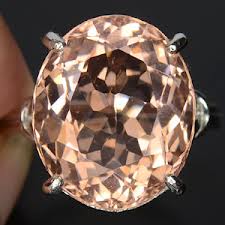Buy Morganite Stones in Vancouver
September 08, 2021
Have you ever heard of or seen a Morganite jewel? I hadn’t until recently when I came across a picture of one in a magazine. Its colour, an exquisite pink, is similar to that of the Rubellite but, unlike the Rubellite whose pedigree dates back to the early nineteenth century, the Morganite is a comparative newcomer to the gem world. In fact, it was only discovered in the very early 20th century in California, then in Madagascar and Brazil followed by discovery of small deposits in Afghanistan, Russia, Namibia, and Mozambique.
At that time, it was not recognized as a separate gemstone so was referred to as a ‘pink beryl’. But its undeniable beauty set it apart from the pink beryl and it was soon being seen as an alternative or challenger to the pink tourmaline, pink sapphire, and Kunzite (another new gem for me and maybe you too).
Family Tree & Name Origin Though not a family tree in the true or strict definition of the term, the Morganite is closely related – known as a sister stone – to the aquamarine and emerald. Not until1911 was this beautiful stone finally recognized as a separate gem and given the name Morganite by Tiffany’s self-taught gemologist and VP George F. Kunz – this is the nod to the gem Kunzite, as it was named for him – in honour of American banker and gem collector J. P. Morgan for his gemological and mineral contributions to the American Museum of Natural History in New York.
I really have no idea how gems are named or who chooses the names but I find this history of the Morganite fascinating. And equally fascinating is the origin of how this unique gem was given the name Morganite by George Kunz to honour and pay tribute to his colleague, J.P. Morgan, who was also Kunz’ personal benefactor, a collector of gemstones, and a customer at Tiffany’s in New York where, at that time, much of the country’s morganite was sold.
Morganite & Kunzite Colours
Morganites’ colour and clarity are due to trace amounts of manganese to give them a brilliant lustre that sets them apart from other pink stones. The colour, however, is always pale or pastel in various shades of pink, peach, peachy-pink, violet-pink and pink blends such as apricot, lavender, and a salmon colour and therefore suit or compliment every skin colour to make a Morganite ideal for everyday wear and, some believe, the perfect antidote to the stresses of modern life. Morganites are pastel colours by nature, so stones in intense or strong hues are extremely rare, with other rarities being a star and/or the cat’s-eye effect. But if the stones are large they are magnificently coloured such as the best-ever found in the very first deposit in Madagascar in a sensational magenta colour.
The Morganite’s colour in terms of intensity and saturation is therefore important because this is how it is valued. Its normal shades, moreover, have put pink into the limelight and made the colour fashionable. A recent example of pink’s new popularity was English actor Dame Helen Mirren (The Queen), sporting pink hair, at an event in Hollywood. And the only disadvantage to a Morganite is its scarcity.
Kunzite, which was discovered in 1902, also comes in colours of pink, lavender, and lilac, as well as other colours and, like Morganite, has traces of manganese. Unlike Morganite, however, that maintains its brilliance, clarity, and lustre, Kunzite fades when exposed to sunlight.
I’m not sure if I have adequately described either of these unique stones with their incredible, interesting histories but if you were to go to LL Private Jewellers you could see for yourself how beautiful and desirable they are, especially the Morganite. And before they become really popular, which would mean a higher price tag, now would be the time to buy if you are ‘on the market’ for a new and exciting gem.
LL Private Jewellers sell fine quality of Morganite of all shapes and sizes. For more information about Morganite please contact us.
